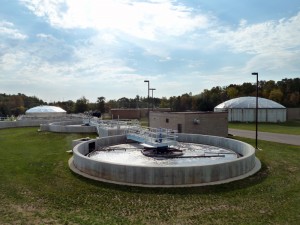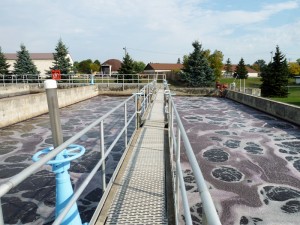Rice Lake Completes Plant Upgrade
Rice Lake Utilities owns and operates a 2.2 mgd wastewater treatment facility (WWTF) that treats wastewater generated within its service area in the City of Rice Lake and discharges to the Red Cedar River. The original plant on the site was built in 1951. The liquid treatment facilities consisted of primary clarification and a high rate trickling filter and final clarification for secondary treatment, with anaerobic digestion and sludge drying beds for solids treatment.
Previous Plant Upgrades
The plant was upgraded in 1981, with some of the existing structures at the plant being retained and converted to different uses:
- A new headworks building was constructed at the head of the facility with a mechanical bar screen and grit classifier.
- One of the primary clarifiers was converted into an aerated grit chamber and aerated wet well, and the second primary clarifier was converted into a chlorine contact tank.
- The trickling filter was demolished.
- Aeration basins using the contact stabilization process and two new final clarifiers were constructed on the site of the old drying beds.
- The new Administration Building was constructed over the existing final clarifiers, which were repurposed as the foundation and lower level.
- Sludge thickening facilities were also installed in a section of the Administration Building.
In 1997, the contact stabilization plant was changed to conventional aeration with biological phosphorus removal using the A2O process. A sludge storage facility was constructed to house the thickened digested sludge, along with a pump station for loading the sludge hauling trucks.
Most Recent Upgrade
In 2007, the Utility completed an operation and needs review, which identified and prioritized a list of necessary infrastructure improvements at the plant. The Utility hired Applied Technologies, Inc. (ATI) to prepare a Facilities Plan and provide design and construction services for the upgrade. The facility improvements were completed in 2012, and the facility is designed to meet the City of Rice Lake’s wastewater treatment needs through the year 2030.
The WWTF improvements made a number of changes to existing treatment facilities and added new facilities. New primary treatment facilities were constructed and include two primary clarifiers and a new Primary Treatment Building. The building houses the primary sludge and scum pumps, which transfer solids directly to the anaerobic digesters. A chemical phosphorus removal system consisting of a storage tank and chemical pumps was installed as backup to the facility’s biological phosphorus removal. A new aeration basin was constructed to provide additional treatment capacity; biological phosphorus removal facilities were installed in the new basin. An anoxic and an anaerobic selector were constructed in the new basin and are mixed with floating mixers. The existing basins’ coarse bubble diffusers were replaced with fine bubble membrane diffusers to improve mixing and treatment efficiency.
The Rice Lake WWTF accepts various types of hauled waste, including septage/holding tank waste, grease trap waste/salt whey, and landfill leachate. The nature of some of these wastes was causing maintenance and operational issues at the existing septage receiving station. A separate receiving system was constructed to store and manage the grease and salt whey waste streams to alleviate the maintenance and storage issues the facility experienced. Two submersible chopper were installed in the new system’s storage tank to provide mixing and to pump the grease/salt whey to the anaerobic digesters. In addition, various improvements were made to the existing septage receiving facilities, including removing non-functioning equipment, improving piping layouts, and replacing the submersible grit pumps.
The existing anaerobic digesters were modified and rehabilitated for continued use as the sludge stabilization process. The fixed, concrete digester covers were removed from both digesters and replaced with a steel floating cover on the primary digester and a steel gas holding cover on the secondary digester. The digester gas bubbler mixing system was replaced, with a draft tube mixer installed in each digester to thoroughly mix the digester contents. A new digester gas flare and new digester gas handling safety equipment was installed, along with all new digester gas piping.
Miscellaneous improvements included replacing the plant’s influent pumps, extensive HVAC improvements in the preliminary treatment building and solids thickening room, rehabilitation of the grit chamber, and replacement of the grit classifier. The dual-fuel combination boiler and heat exchanger was replaced in kind. The existing centrifugal aeration blowers were replaced with rotary lobe blowers. A new supervisory, control, and data acquisition (SCADA) system was installed to provide improved control over facility process. Hot water heating was extended to the preliminary treatment building and the sludge storage operation building.
Leave a Comment